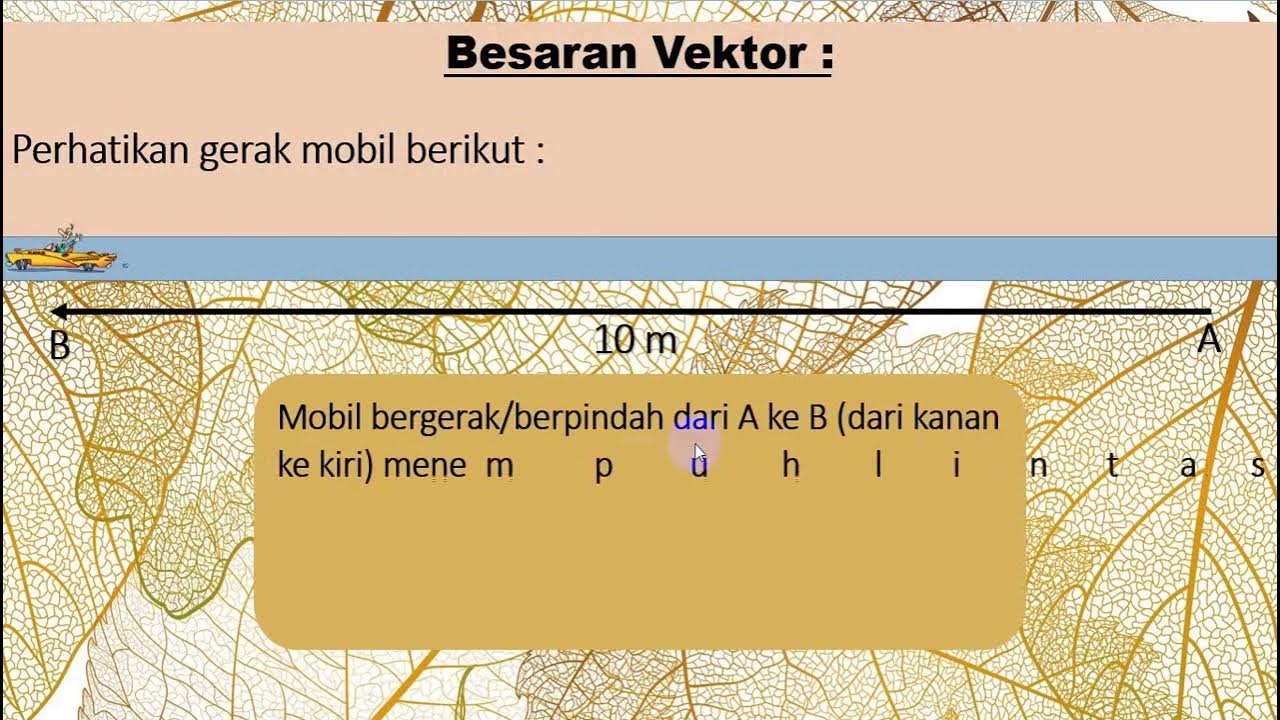Scalars, Vectors, and Vector Operations
Summary
TLDRIn this video, Professor Dave introduces the fundamental concepts of scalars and vectors in physics. He explains the difference between scalars (quantities with only magnitude) and vectors (quantities with both magnitude and direction). The video covers vector addition, subtraction, and operations such as breaking a vector into its components, as well as using trigonometry to find angles and solve problems. Through examples like motion in a river with current, the viewer learns how to apply these concepts to real-world physics problems. The tutorial sets the stage for deeper exploration into forces and motion in future lessons.
Takeaways
- 😀 Scalars are quantities that only have magnitude, such as mass, time, or temperature.
- 😀 Vectors are quantities that have both magnitude and direction, and are crucial for understanding forces and motion in physics.
- 😀 The length of a vector represents its magnitude, while the direction indicates which way the vector is pointing.
- 😀 Vector addition involves placing vectors head to tail and finding the resultant vector from the starting point of the first to the end of the second.
- 😀 When vectors are perpendicular, their resultant vector's magnitude can be found using the Pythagorean theorem.
- 😀 Trigonometric functions (sine, cosine, tangent) are used to solve for unknown angles and sides in right-angled triangles.
- 😀 When subtracting vectors, you invert the direction of the second vector, which is equivalent to adding its negative.
- 😀 Vector components can be broken down into X and Y components using trigonometry, useful for analyzing motion like projectile motion.
- 😀 A vector multiplied by a scalar changes its magnitude but not its direction.
- 😀 In real-world scenarios, such as a boat moving in a river, vector addition helps calculate resultant speed and direction by combining the boat's velocity and the current's velocity.
Q & A
What is the primary difference between a scalar and a vector?
-A scalar is a quantity that only has magnitude (size), such as mass, time, or temperature. A vector, on the other hand, has both magnitude and direction, like force or velocity.
Why are vectors important in physics?
-Vectors are crucial in physics because they allow us to represent quantities that have both magnitude and direction, such as forces, velocities, and accelerations. These directions are key for understanding the behavior of objects.
How do you add two vectors together?
-To add two vectors, place the second vector at the end of the first vector and draw a new vector from the start of the first to the end of the second. The direction and magnitude of the new vector represent the sum.
What is the result of adding two vectors that are pointing in the same direction?
-When two vectors point in the same direction, their sum is simply the vector obtained by adding their magnitudes together, resulting in a longer vector.
What happens when two vectors are perpendicular to each other?
-When two vectors are perpendicular, their resultant vector is the hypotenuse of a right triangle formed by the two original vectors. The magnitude of the resultant vector is found using the Pythagorean theorem.
How do you calculate the magnitude of a resultant vector when the vectors are perpendicular?
-To calculate the magnitude of the resultant vector when vectors are perpendicular, use the Pythagorean theorem: A² + B² = C², where A and B are the magnitudes of the original vectors, and C is the magnitude of the resultant.
What is the significance of trigonometric functions in vector operations?
-Trigonometric functions help in determining angles and the components of vectors. They relate the angles of right triangles to the lengths of the sides, making it easier to break vectors into horizontal and vertical components.
How do you perform vector subtraction?
-To subtract vectors, reverse the direction of the second vector and add it to the first vector. This is equivalent to adding the first vector to the negative of the second vector.
What is the importance of breaking a vector into its components?
-Breaking a vector into its components is crucial for analyzing motion in multiple directions. For example, in projectile motion, it helps separate the horizontal and vertical components, which behave independently under the influence of gravity.
How do you multiply a vector by a scalar?
-To multiply a vector by a scalar, multiply the magnitude of the vector by the scalar while keeping its direction the same. This changes the length of the vector but not its direction.
How do you find the speed and direction of an object using vectors in real-life problems?
-To find the speed and direction of an object, such as a boat in a river, represent the object's velocity and the current as vectors, then add them. The magnitude of the resultant vector gives the speed, and the direction is found using trigonometry.
In the boat and river example, what is the resultant speed of the boat?
-In the boat and river example, the resultant speed of the boat is the magnitude of the vector sum, which is the square root of 17, or approximately 4.12 meters per second.
Outlines

هذا القسم متوفر فقط للمشتركين. يرجى الترقية للوصول إلى هذه الميزة.
قم بالترقية الآنMindmap

هذا القسم متوفر فقط للمشتركين. يرجى الترقية للوصول إلى هذه الميزة.
قم بالترقية الآنKeywords

هذا القسم متوفر فقط للمشتركين. يرجى الترقية للوصول إلى هذه الميزة.
قم بالترقية الآنHighlights

هذا القسم متوفر فقط للمشتركين. يرجى الترقية للوصول إلى هذه الميزة.
قم بالترقية الآنTranscripts

هذا القسم متوفر فقط للمشتركين. يرجى الترقية للوصول إلى هذه الميزة.
قم بالترقية الآن5.0 / 5 (0 votes)






